Discover 20 hidden attractions, cool sights, and unusual things to do in Ravenna (Italy). Don't miss out on these must-see attractions: Basilica di San Vitale, Mausoleo di Galla Placidia, and Basilica di Sant'Apollinare in Classe. Also, be sure to include Baptistery of Neon in your itinerary.
Below, you can find the list of the most amazing places you should visit in Ravenna (Emilia-Romagna).
Table of Contents
Basilica di San Vitale
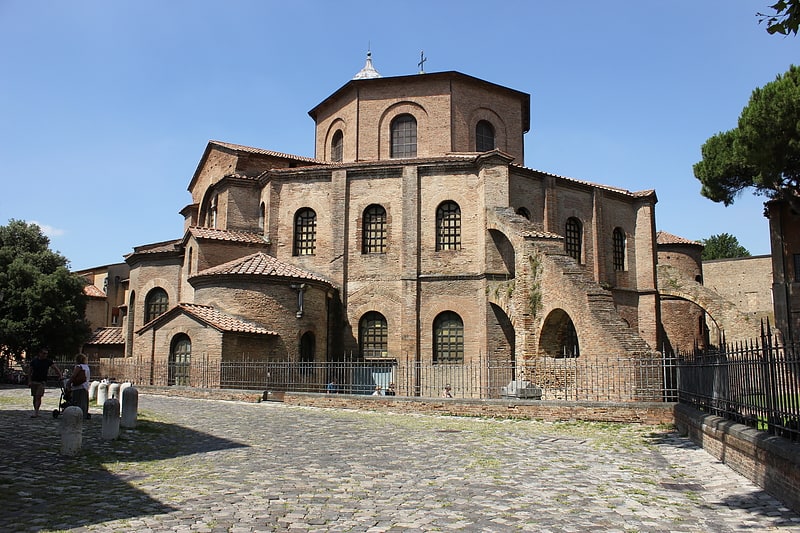
Colorful mosaics in a 6th-century church. The Basilica of San Vitale is a late antique church in Ravenna, Italy. The 6th century church is an important surviving example of early Christian Byzantine art and architecture. It is one of eight structures in Ravenna inscribed on the UNESCO World Heritage List. Its foundational inscription describes the church as a basilica, though its centrally-planned design is not typical of the basilica form. The Roman Catholic Church has designated the building a "basilica", an honorific title bestowed on exceptional church buildings of historic and ecclesial importance.[1]
Address: Via San Vitale, 17, 48121 Ravenna
Mausoleo di Galla Placidia
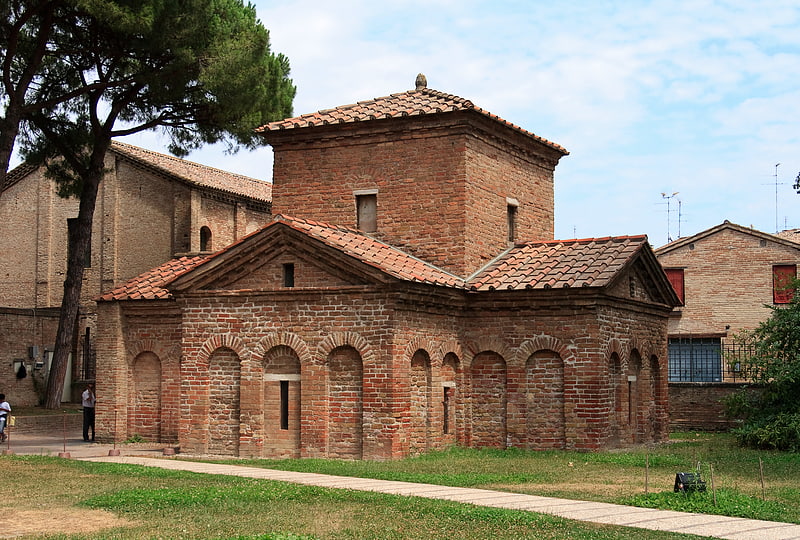
5th-century chapel with colorful mosaics. The Mausoleum of Galla Placidia is a Late Antique Roman building in Ravenna, Italy, built between 425 and 450. It was added to the World Heritage List together with seven other structures in Ravenna in 1996. Despite its common name, the empress Galla Placidia was not buried in the building, a misconception dating from the thirteenth century; she died in Rome and was buried there, probably alongside Honorius in the Mausoleum of Honorius at Old Saint Peter's Basilica.[2]
Address: Via Giuliano Argentario, 22, 48110 Ravenna
Basilica di Sant'Apollinare in Classe
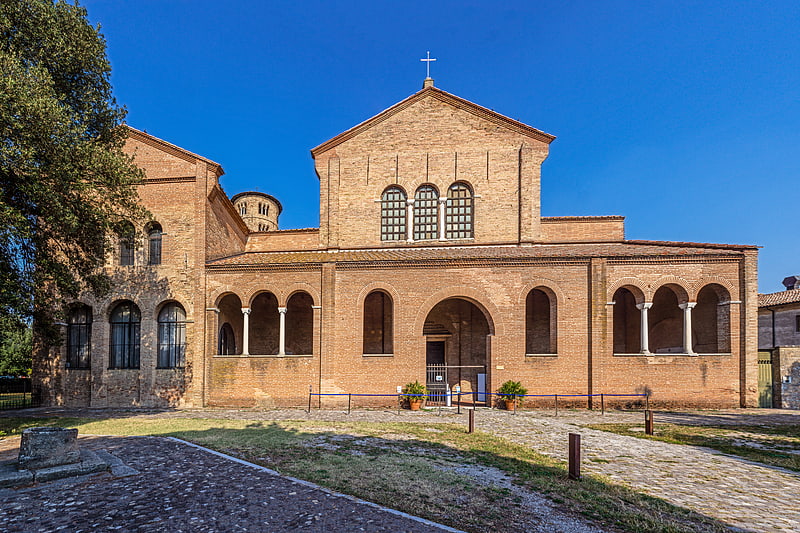
Colorful mosaics in a 6th-century church. The Basilica of Sant' Apollinare in Classe is a church in Classe, Ravenna, Italy, consecrated on 9 May 549 by the bishop Maximian and dedicated to Saint Apollinaris, the first bishop of Ravenna and Classe. An important monument of Byzantine art, in 1996 it was inscribed with seven other nearby monuments in the UNESCO World Heritage List, which described it as "an outstanding example of the early Christian basilica in its purity and simplicity of its design and use of space and in the sumptuous nature of its decoration".[3]
Address: Via Romea Sud, 224, 48124 Classe
Baptistery of Neon
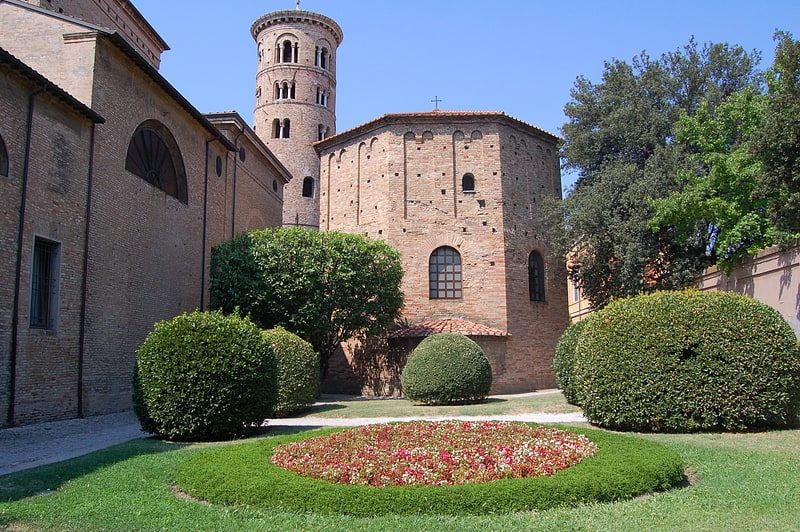
Also known as: Battistero Neoniano
Baptistery with Byzantine mosaics. The Baptistery of Neon is a Roman religious building in Ravenna, northeastern Italy. The most ancient monument remaining in the city, it was partly erected on the site of a Roman bath. It is also called the Orthodox Baptistery to distinguish it from the Arian Baptistery constructed on behest of Ostrogothic King Theodoric some 50 years later.[4]
Address: Piazza Duomo, 1, 48121 Ravenna
Mausoleum of Theodoric
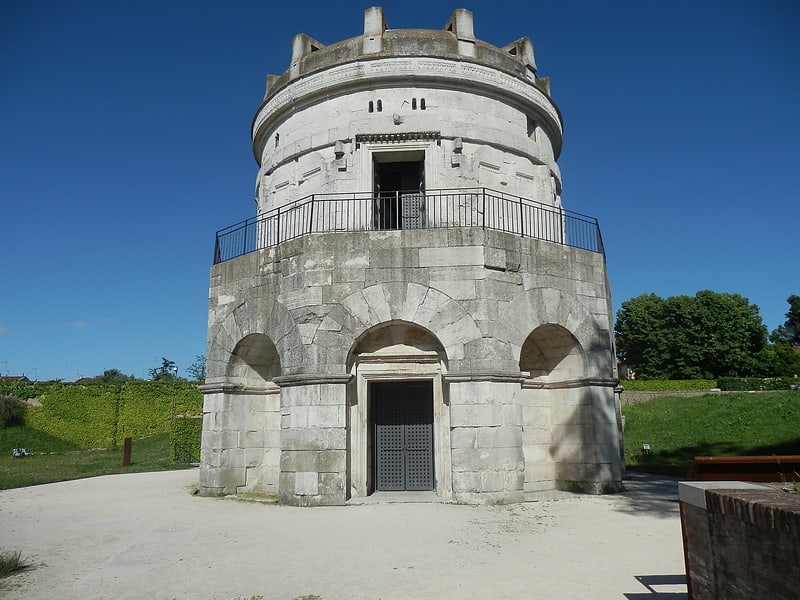
Also known as: Mausoleo di Teodorico
Circular, 6th-century Gothic tomb. The Mausoleum of Theodoric is an ancient monument just outside Ravenna, Italy. It was built in 520 AD by Theodoric the Great, king of the Ostrogoths, as his future tomb.[5]
Address: Via delle Industrie, 14, 48122 Ravenna
ISpeed
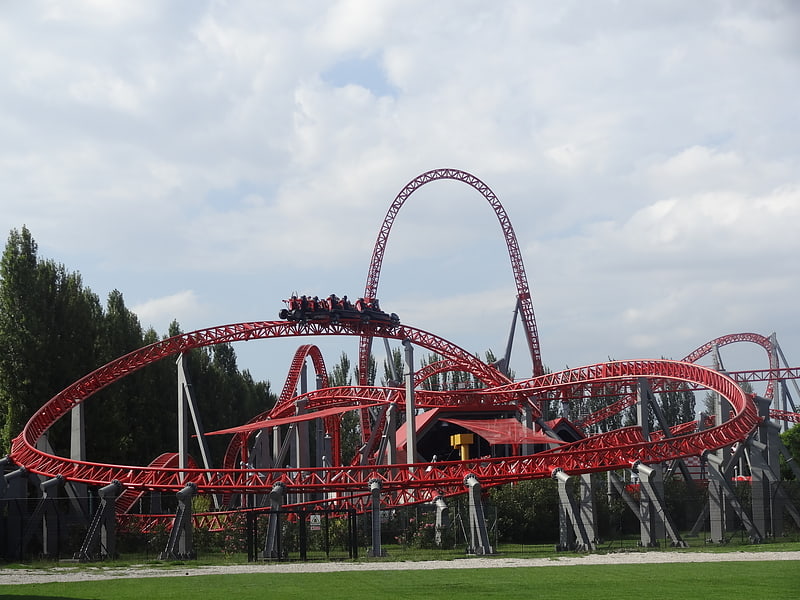
Also known as: ISpeed
Roller coaster in Italy. iSpeed is a steel roller coaster at Mirabilandia in Italy. It opened on May 20, 2009, and is the second blitz coaster to be made by Intamin following Maverick at Cedar Point in Sandusky, Ohio.[6]
Address: Strada Statale 16 Adriatica, km 162, 48125 Ravenna
Arian Baptistery
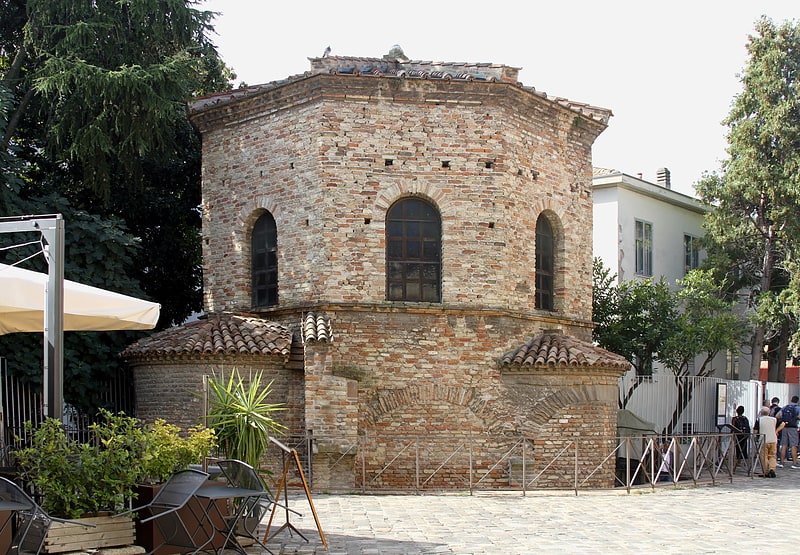
Also known as: Battistero degli Ariani
5th-century UNESCO-listed baptistery. The Arian Baptistry in Ravenna, Italy is a Christian baptismal building that was erected by the Ostrogothic King Theodoric the Great between the end of the 5th century and the beginning of the 6th century A.D. at the same time as the Basilica of Sant' Apollinare Nuovo.
Theodoric was an Arian Christian and decided to let the Goths (Arians) and the Orthodox Chalcedonian Christians live together but separately, and so there were separate neighborhoods and separate religious buildings.
Near his palace, the king commissioned an Arian cathedral, now called the Church of Spirito Santo, but originally named Hagia Anastasis (Holy Resurrection). It was re-consecrated as the Chalcedonian cathedral of Saint Teodoro (soldier and martyr of Amasea in Pontus) in 526 AD. Little remains of the original church after its reconstruction in 1543; some historians speculate that the original mosaics were lost over a thousand years earlier during its Catholic reconstruction due to Arian themes. During this same period, Theodoric also had the baptistry built, today referred to as "of the Arians" in order to distinguish it from the Baptistry of Neon (of the Orthodox) which is about one century older.[7]
Address: Piazzetta degli Ariani, 48121 Ravenna
Santa Maria del Suffragio

Santa Maria del Suffragio is a Late-Baroque-style, Roman Catholic church located on Via Serafino Ferruzzi in Ravenna, region of Emilia Romagna, Italy.
The church was designed by Francesco Fontana, son of Carlo Fontana, and erected between 1701 and 1728. The church was commissioned by the Confraternity of Beata Vergine dei Suffragi. The layout of the church is octagonal. Antonio Martinetti sculpted the eight stucco statues of the inside. The main altarpiece is by Andrea Barbiani. The statues and bas-reliefs of the façade are by Celio and Giovanni Toschini.[8]
Address: Via Serafino Ferruzzi, 1, 48121 Ravenna
Ravenna Cathedral
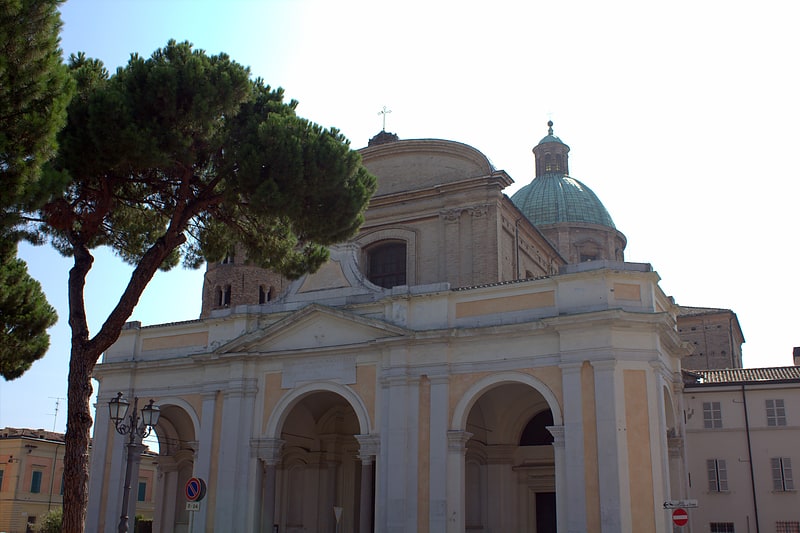
Also known as: Duomo di Ravenna
Cathedral in Ravenna, Italy. Ravenna Cathedral is a Roman Catholic cathedral dedicated to the Resurrection of Jesus Christ in the city of Ravenna, Italy. Formerly the archiepiscopal seat of the Archdiocese of Ravenna, it is now the seat of the archbishops of Ravenna-Cervia. It was granted the status of a minor basilica by Pope John XXIII on 7 October 1960. It is also the seat of the parish of San Giovanni in Fonte belonging to the Urban Vicariate of the archdiocese of Ravenna-Cervia.
The present 18th-century Baroque building followed the demolition of the ancient cathedral, the early 5th-century Basilica Ursiana.
On the top of the belltower there are four bells in chord of D minor.[9]
Address: Via Battistero 2, 48121 Ravenna
Basilica of Sant'Apollinare Nuovo
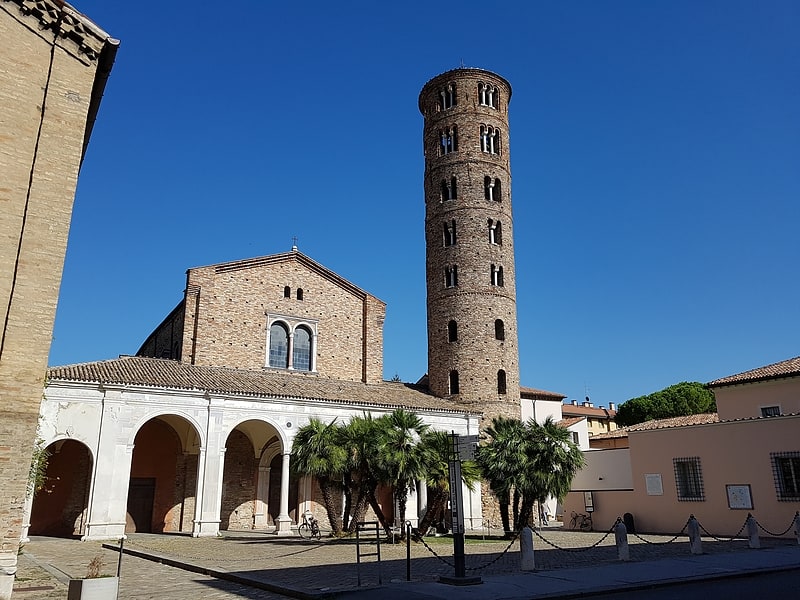
Also known as: Basilica di Sant'Apollinare Nuovo
6th-century basilica church with mosaics. The Basilica of Sant'Apollinare Nuovo is a basilica church in Ravenna, Italy. It was erected by the Ostrogothic king Theodoric the Great as his palace chapel during the first quarter of the 6th century. This Arian church was originally dedicated in 504 AD to "Christ the Redeemer".
It was reconsecrated in 561 AD, under the rule of the Byzantine emperor Justinian I, under the new name "Sanctus Martinus in Coelo Aureo" ("Saint Martin in Golden Heaven"). Suppressing the Arian church, the church was dedicated to Saint Martin of Tours, a foe of Arianism. According to legend, Pope Gregory the Great ordered that the mosaics in the church be blackened, as their golden glory distracted worshipers from their prayers. The basilica was renamed again in 856 AD when relics of Saint Apollinaris were transferred from the Basilica of Sant'Apollinare in Classe because of the threat posed by frequent raids of pirates from the Adriatic Sea.
Its apse and atrium underwent modernization at various times, beginning in the 6th century with the destruction of mosaics whose themes were too overtly Arian or which expressed the king's glory, but the mosaics of the lateral walls, twenty-four columns with simplified Corinthian capitals, and an Ambo are preserved. On some columns, images of arms and hands can be seen, which are parts of figures once representing praying Goths and Theodoric's court, deleted in Byzantine times. Renovations (and alterations) were done to the mosaics in the mid-19th century by Felice Kibel. The present apse is a reconstruction after being damaged during World War I.[10]
Archiepiscopal Museum

Also known as: Museo arcivescovile di Ravenna
Museum in Ravenna, Italy. The Archiepiscopal Museum is located in Ravenna, Italy, next to the Baptistry of Neon and behind the Duomo of Ravenna. In the museum relics of early Christian Ravenna are preserved, including fragments of mosaic from the first cathedral church, and the chapel of Sant'Andrea, dating from the Gothic kingdom.
The main room, on entering, contains lapidary inscriptions as HIC REQUIESCIT IN PACE VIR SBL SEDA IGNUCUS ('Here lies in peace that eminent man Seda the Eunuch'), CUBICULARIUS or 'Bedchamberlain' to Theodoric the Great, buried 541 AD. Beneath this, by the window, a reliquary for the martyred saints Quiricus and Julietta, whose remains were carried from Tarsus, the birthplace of Saint Paul, to Auxerre and from thence to Ravenna. The depictions on its four facings are in keeping with the theme of donation: Galla Placidia placed it in the church of San Giovanni Battista (not to be confused with the church of the 'Evangelista'). They are:
- Christ giving the Tables of the Law to St. Peter, with Paul standing by him;
- Daniel in the lions' den, with the prophet Habakkuk offering him a loaf and fishes;
- The Three Wise Kings bringing their gifts to the infant Christ;
- The women sitting below at His empty tomb.
The marble rosette on the facing wall is a Paschal calendar of the 6th century. Its purpose was to fix the movable feast of Easter in such a way that it might be celebrated everywhere in Christendom on the same day - no easy matter when East and West were using different calendars: the Eastern Church used the Hebrew lunar calendar, while the Western church followed the sun's cycle. Despite the decrees of the Council of Nicea in 325 AD and the tables of Theophilus, in this, as in all matters of faith, people followed their own loyalties. This calendar follows the eastern lunar cycle: LV on the outer rim, followed by AN indicates the phase of its 19-year cycle; the date then for Easter is written in each recurring phase from 532 AD to 626 AD.
The mosaics are the few fragments left of what covered the apse of the first church: they are not Roman originals but of the early 12th century. The most beautiful and intact is that of the Madonna, praying in the eastern manner; other fragments give some idea of its composition - the life of Sant'Apollinare, the patron saint and evangeliser of Ravenna; scenes of the Resurrection; Saints Peter and Paul. On entering the room to the right, there is a little stele depicting Christ the Good Shepherd by a tree: it is the tombstone of Antiphon, who died aged 17 years, 5 months and 12 days, sometime at the end of the 2nd/beginning of the 3rd century, long before the Edict of Tolerance, and is thus the earliest Christian record in Ravenna. The red porphyrian man (drawing or sheathing his sword?), headless, handless, footless, may be the Emperor Theodosius. It recalls the statue of the Tetrarchs outside the Doge's Palace in Venice, gripping onto power.
The jewel of the collection is the Ivory Cathedra, the bishop's seat of the Byzantine era (6th century), considered among the finest pieces of ivory carving in Western art. It is placed in what was the tower of Porta Salustra, the Roman gateway which commanded the southern entrance along the Cardis. It is the work of different hands and, even allowing for the missing panels, it still remains a visible masterpiece: the front bench, with the figures of Saint John the Baptist flanked by the Evangelists and a frieze work of peacocks, lions, goats and deer among vines, is especially fascinating; the backrest represents scenes from the birth of Christ, including Mary proving her virginity by immersion; on the other side, the miracles of Christ, his baptism and entry into Jerusalem; the armrests depict the Old Testament life of Joseph, reading from left to right (for the sitter).[11]
Address: Piazza Arcivescovado, 1, 48121 Ravenna
Chiesa di San Giovanni Battista

San Giovanni Battista is a baroque church in the historic center of Ravenna, Italy, built in 1689 by Pietro Grossi.
The church here, a three-nave basilica, was built in the 6th century. In 1688, it was strongly damaged by an earthquake, demolished, and a new building was constructed in the same place. Parts of the apse of the old building survived, as well as the bell-tower built in the 9th-10th centuries.[12]
Address: Via Girolamo Rossi, 45, 48121 Ravenna
Teatro Comunale Alighieri
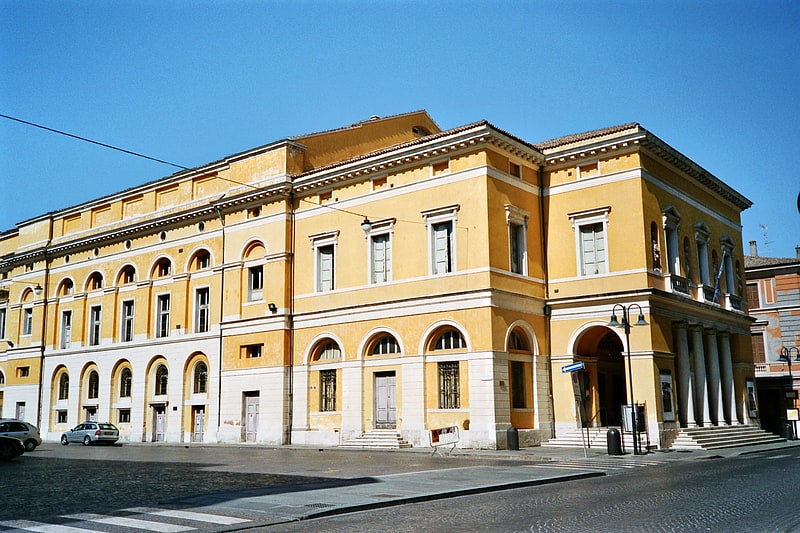
Also known as: Teatro Dante Alighieri
Opera house in Ravenna, Italy. The Teatro Comunale Alighieri is an opera house located at 2 Via Mariani in Ravenna, Italy and designed by the Venetian architects, Tommaso Meduna and his brother, Giambattista who had designed the second La Fenice theatre after the fire of 1836. The new Teatro Comunale Alighieri was inaugurated on 15 May 1852 with a production of Meyerbeer's Robert le diable, followed by Giovanni Pacini's Medea.
It presently offers a program of up to six operas during the season which runs from November to April.
For about 125 years following 1723, Ravenna had one main theatre for the presentation of opera, the Teatro Comunitativo located outside the centre of the city. It featured a lavishly decorated, U-shaped baroque auditorium with 97 boxes on four tiers. In the 50 years following 1802, it presented 170 operatic productions, 24 of which were by Rossini, 22 by Donizetti, and 10 by Verdi. However, the 1830s and 1840s revealed its inadequacy, and plans were made to build a new theatre in the heart of the city; the cornerstone of the replacement theatre was laid in 1840.
With construction continuing until 1852, the new Teatro Comunale was named for the famous poet, Dante Aligheri, who had been exiled from Florence and then spent the last four years of his life in Ravenna. Reflecting the style of the Venetian brothers, the exterior of the Alighieri is neo-classical with a four ionic columns and a portico with statues of four Muses. With 118 boxes in four tiers plus a gallery, the auditorium was constructed in the traditional horseshoe shape with 830 seats.
As befitting his position as the major operatic composer of the day, Giuseppe Verdi's operas were dominant at the new theatre during its first fifty years; of other composers' works, Donizetti's operas were the only ones which appeared regularly until 1870 and those of Bellini vanished after 1866. However, French grand opera survived until the 20th century.
Since its foundation in 1990, the annual June/July Ravenna Festival has presented a very diverse range of operas at the Alighieri. These have included rare works by Salieri, Auber, and Cherubini as well as less performed operas by many of the standard 19th-century composers plus more popular works.[13]
Address: Via Dante Alighieri 1, 48121 Ravenna
Candiano Canal
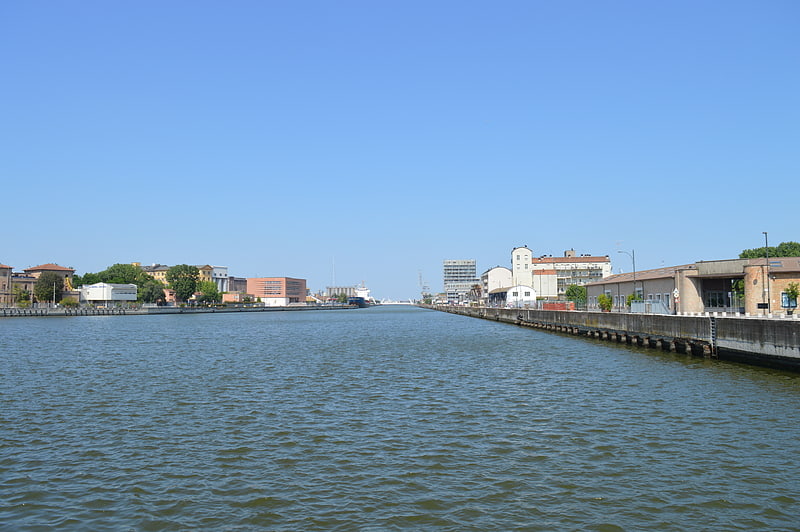
River. The Candiano Canal, also known as the Canal Corsini, is a canal connecting the Italian city of Ravenna to the Adriatic Sea. The canal was built as part of a construction program begun by Pope Clement XII in the early 18th century. The artificial waterway connects the Monote and Ronco rivers to the Adriatic Sea. At 11 km long, the canal is the largest artificial canal in Italy.[14]
Archbishop's Chapel
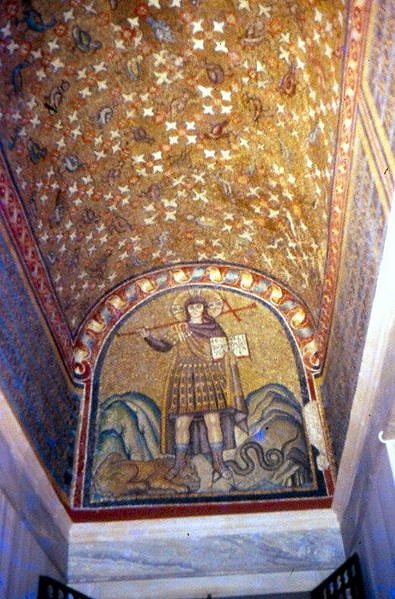
Also known as: Cappella Arcivescovile
Chapel in Ravenna, Italy. The Archbishop's Chapel is a chapel on the first floor of the bishops' palace in Ravenna, Italy, the smallest of the famous mosaic sites of the city. It is a private oratory of Trinitarian bishops dating from the turn of the 6th century. Although commonly attributed to St. Peter Chrysologus, Archbishop of Ravenna from 433–450, the chapel was actually built by Peter II shortly after he became archbishop in 495. The mosaics date from the original construction, or soon after.[15]
Address: Piazza Arcivescovado, 1, Ravenna
Domus dei Tappeti di Pietra
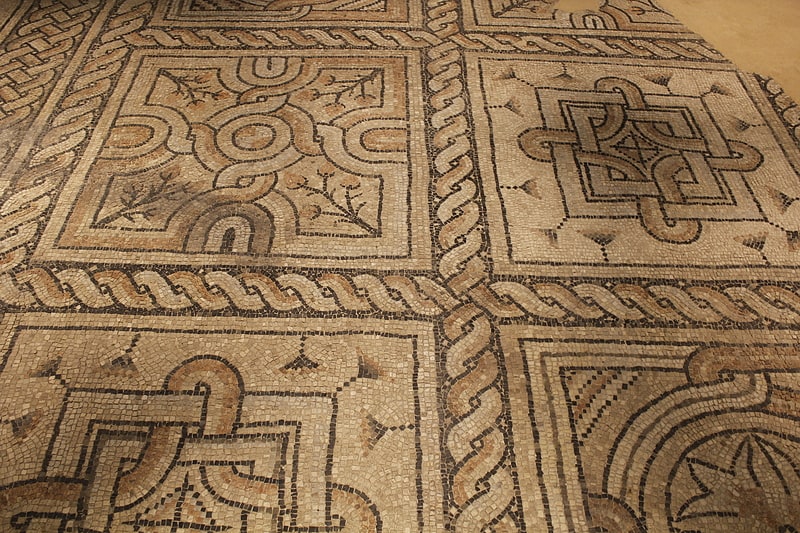
The Domus of the Stone Carpets is an archaeological site in the city of Ravenna located in an underground environment about three meters below the Church of St. Euphemia.
Address: Via Barbiani, 48121 Ravenna
Mirabilandia Beach

Mirabeach, until 2011 known as Mirabilandia Beach, is a water park, a section of the larger Italian theme park Mirabilandia, near Ravenna, within which it is located. Built in 2003, resulting in a major expansion of Mirabilandia to the northwest, it covers an area of 120,000 m² and consists of beaches, pools, water slides, green spaces, bars, restaurants and stores, resembling a tropical paradise island, comparable to a beach in the Red Sea, the Caribbean, Hawaii or Polynesia. In fact, the palm trees come from Brazil and the silicon-white sand, which does not burn in the sun, was imported from Sharm el-Sheikh.
Address: S.S. Adriatica Km 162, Ravenna
Safari Ravenna
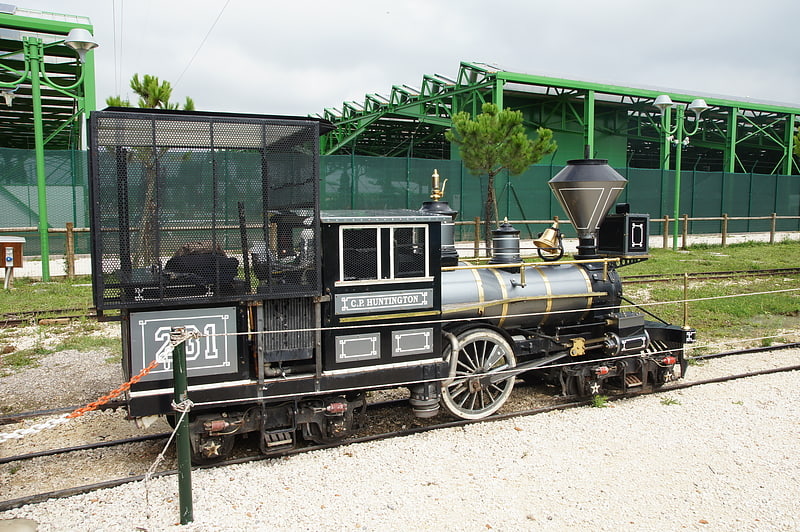
Safari park in Italy. Safari Ravenna is a Safari park and Zoo in Ravenna, Emilia-Romagna, Italy, created in 2012 near the amusement park of Mirabilandia; extending over an area of 340.000 square metres. There is a large area for large mammals and birds to be seen only by car or train, and a smaller traditional zoo with the Reptile section, Primates, Australian section and domestic animals.[16]
Address: Via Dei Tre Lati 2x, 48125 Ravenna
Basilica di San Francesco
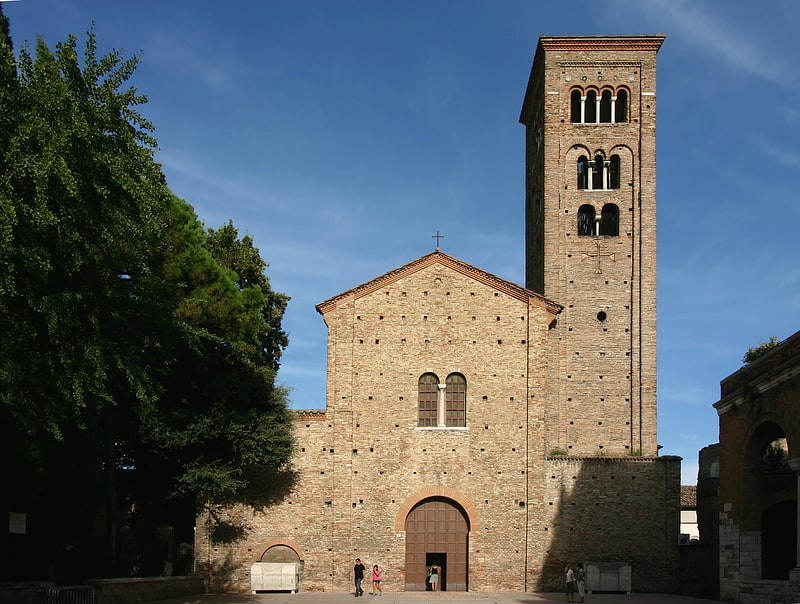
Basilica in Ravenna, Italy. The Basilica of San Francesco is a major church in Ravenna. It was first built in 450 by Neo, bishop of Ravenna, and dedicated to saint Peter and Saint Paul. It was later also known as the Church of the Apostles. In the second half of the 9th century and over the course of the 10th century, the earlier church was demolished to build a larger one and a tall bell tower, both of which survive. This new church was dedicated to Saint Peter and named San Pietro Maggiore. It was handed over to the Franciscans in 1261 and rededicated to Francis of Assisi.
Dante Alighieri's funeral was held in the church in 1321 and his remains still rest next to the church in the Tomb of Dante. Between 1500 and 1700 the church was restored again and again and Baroque altars and decorations were added. The most important restoration was that under Pietro Zumaglini in 1793. Ravenna was occupied by the French soon afterwards and in 1810 the monastery was suppressed, with its buildings confiscated by the authorities but the church kept open as a parish church, which it still is. Between 1918 and 1921, in preparation for the 600th anniversary of Dante's death, the church was radically restored, removing all the Baroque additions and returning it to something like its original style. A competition was held during the anniversary for a new scheme inside the church based on Dante's best known work, the Divine Comedy. Adolfo De Carolis won the competition but his sudden death prevented his scheme from being realised. The crypt was restored between 1926 and 1970 and in 1949 the Franciscans took on the church once again. Instead of the old monastery buildings, they moved into a building opposite the church and continued to run it as a parish church.[17]
Address: Via Guido da Polenta, 6, 48121 Ravenna
St. John the Evangelist Church

Also known as: Chiesa di San Giovanni Evangelista
Catholic church in Ravenna, Italy. San Giovanni Evangelista is a church in Ravenna, Italy.
It was built in the fifth century AD by the Roman imperial princess Galla Placidia.
In the Middle Ages the Benedictines annexed to it an important monastery. In the 14th century both the church and the monastery were renovated in the Gothic style: of that intervention the portal is visible today. In 1747 the church was almost entirely stripped of its mosaics; the only remaining are two fragments of the original 5th-century floor, with the first recorded Christian use of hooked crosses. Other mosaic fragments found under the bombs belong to 13th-century floor and depict the Fourth Crusade. Two of the four bells dates 1208.
Heavily bombed during World War II, the building was later restored.[18]
Address: Viale Farini, 48121 Ravenna